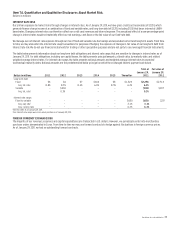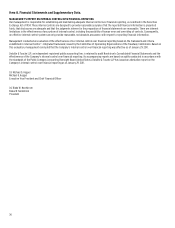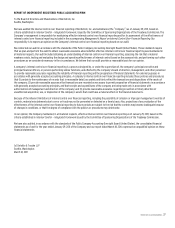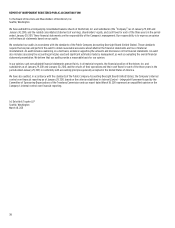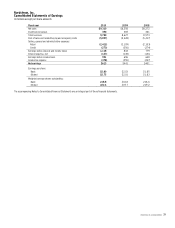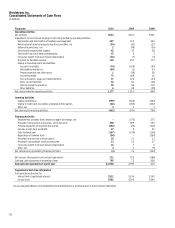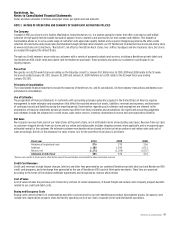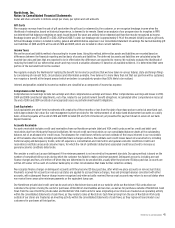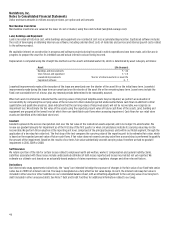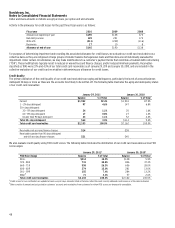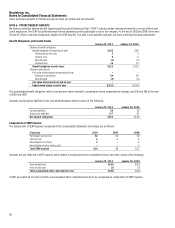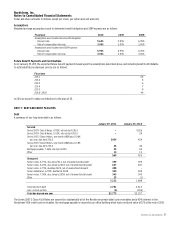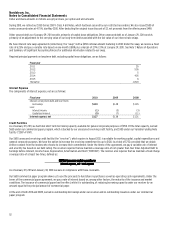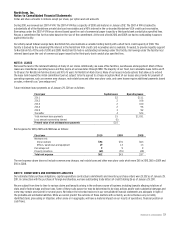Nordstrom 2010 Annual Report Download - page 53
Download and view the complete annual report
Please find page 53 of the 2010 Nordstrom annual report below. You can navigate through the pages in the report by either clicking on the pages listed below, or by using the keyword search tool below to find specific information within the annual report.Nordstrom, Inc. and subsidiaries 45
Nordstrom, Inc.
Notes to Consolidated Financial Statements
Dollar and share amounts in millions except per share, per option and unit amounts
Gift Cards
We recognize revenue from the sale of gift cards when the gift card is redeemed by the customer, or we recognize breakage income when the
likelihood of redemption, based on historical experience, is deemed to be remote. Based on an analysis of our program since its inception in 1999,
we determined that balances remaining on cards issued beyond five years are unlikely to be redeemed and therefore may be recognized as income.
Breakage income was $9, $8 and $7 in 2010, 2009 and 2008. To date, our breakage rate is approximately 3.1% of the amount initially issued as gift cards.
Gift card breakage income is included in selling, general and administrative expenses in our consolidated statement of earnings. We had outstanding gift
card liabilities of $188 and $174 at the end of 2010 and 2009, which are included in other current liabilities.
Income Taxes
We use the asset and liability method of accounting for income taxes. Using this method, deferred tax assets and liabilities are recorded based on
differences between the financial reporting and tax basis of assets and liabilities. The deferred tax assets and liabilities are calculated using the
enacted tax rates and laws that are expected to be in effect when the differences are expected to reverse. We routinely evaluate the likelihood of
realizing the benefit of our deferred tax assets and may record a valuation allowance if, based on all available evidence, it is determined that some
portion of the tax benefit will not be realized.
We regularly evaluate the likelihood of realizing the benefit for income tax positions that we have taken in various federal, state and foreign filings
by considering all relevant facts, circumstances and information available. If we believe it is more likely than not that our position will be sustained,
we recognize a benefit at the largest amount which we believe is cumulatively greater than 50% likely to be realized.
Interest and penalties related to income tax matters are classified as a component of income tax expense.
Comprehensive Net Earnings
Comprehensive net earnings include net earnings and other comprehensive earnings and losses. Other comprehensive earnings and losses in 2010,
2009 and 2008 consisted of adjustments, net of tax, related to our postretirement benefit obligations. Accumulated other comprehensive losses at
the end of 2010 and 2009 consisted of unrecognized losses on postretirement benefit obligations.
Cash Equivalents
Cash equivalents are short-term investments with a maturity of three months or less from the date of purchase and are carried at amortized cost,
which approximates fair value. Our cash management system provides for the reimbursement of all major bank disbursement accounts on a daily
basis. Accounts payable at the end of 2010 and 2009 included $111 and $74 of checks not yet presented for payment drawn in excess of our bank
deposit balances.
Accounts Receivable
Accounts receivable includes credit card receivables from our Nordstrom private label and VISA credit cards as well as credit and debit card
receivables due from third party financial institutions. We record credit card receivables on our consolidated balance sheets at the outstanding
balance, net of an allowance for credit losses. The allowance for credit losses reflects our best estimate of the losses inherent in our receivables
as of the balance sheet date, including uncollectible finance charges and fees. We estimate such credit losses based on several factors, including
historical aging and delinquency trends, write-off experience, concentration and risk metrics and general economic conditions. Credit card
receivables constitute unsecured consumer loans, for which the risk of cardholder default and associated credit losses tend to increase as
general economic conditions deteriorate.
We consider a credit card account delinquent if the minimum payment is not received by the payment due date. Our aging method is based on the
number of completed billing cycles during which the customer has failed to make a minimum payment. Delinquent accounts, including accrued
finance charges and fees, are written off when they are determined to be uncollectible, usually after they become 150 days past due. Accounts are
written off sooner in the event of customer bankruptcy or other circumstances that make further collection unlikely.
We recognize finance charges on delinquent accounts until they become 120 days past due, after which we place accounts on non-accrual status.
Payments received for accounts on non-accrual status are applied to accrued finance charges, fees and principal balances consistent with other
accounts, with subsequent finance charge income recognized only when actually received. Non-accrual accounts may return to accrual status when
we receive three consecutive minimum payments or the equivalent lump sum.
Our Nordstrom private label credit card can be used only in Nordstrom stores and on our website, while our Nordstrom VISA cards allow our
customers the option of using the cards for purchases of Nordstrom merchandise and services, as well as for purchases outside of Nordstrom. Cash
flows from the use of both the private label and Nordstrom VISA credit cards for sales originating at our stores are treated as an operating activity
within the consolidated statements of cash flows, as they relate to sales at Nordstrom. Cash flows arising from the use of Nordstrom VISA cards
outside of our stores are treated as an investing activity within the consolidated statements of cash flows, as they represent loans made to our
customers for purchases at third parties.


